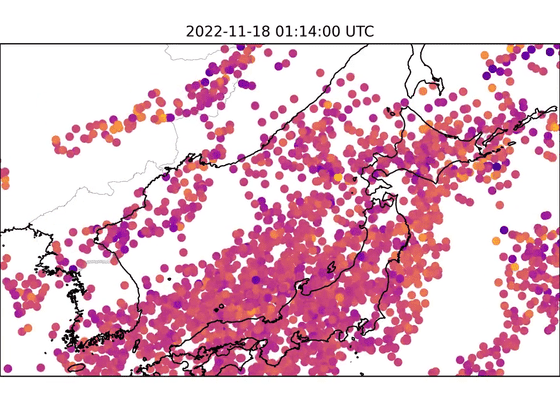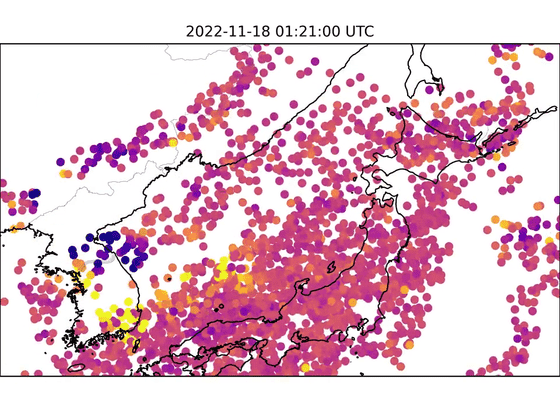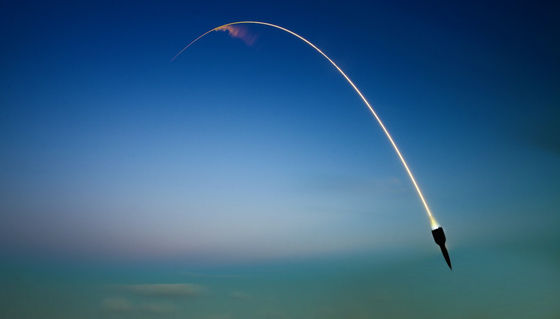Volunteers create a system to detect North Korean ICBMs using GPS satellites

North Korea
A volunteer project used GPS to detect a North Korean missile test | New Scientist
https://www.newscientist.com/article/2348466-a-volunteer-project-used-gps-to-detect-a-north-korean-missile-test/
Jeffrey Lewis of the James Martin Non-Proliferation Research Center in California is the inventor of a system that captures missile and rocket launches with signals emitted by GPS satellites. On Twitter, he posted an animation of what happens when a system inspired by the paper 'SpaceX Rockets Disrupt the Ionosphere' detects a missile launch.
Time to let the cat out of the bag! @tylerni7 and @michaelnute have been writing code to detect missile launches like tonight's North Korean ICBM test in GPS data. Missiles make ionospheric disturbances that GPS records. .twitter.com/knJy7dApPv
— Dr. Jeffrey Lewis (@ArmsControlWonk) November 18, 2022
When you play the movie, you can see countless red dots covering the Japanese archipelago. According to Twitter user Hattrick Coil, this point indicates a signal recorded by about 100 receivers across Japan.

After that, a yellow dot appeared from around the Korean Peninsula and spread to the Sea of Japan. This yellow dot is the point where the disturbance of the ionosphere was detected. The ionospheric turbulence was recorded after 10:00 am on November 18, 2022 Japan time, which matches the

Mr. Tyler Nicewander of cyber security company Theori, who was involved in building this system at the request of Mr. Lewis, first acquired data from the Japanese
According to Professor Kousuke Heki , former Hokkaido University Faculty of Science, the GEONET system consists of 1,300 electronic reference points owned by the Japanese government and 3,000 electronic reference points operated by Softbank.
Over the past several decades, Professor Hioki's research has shown that when a rocket penetrates the ionosphere, water vapor contained in the exhaust gas interacts with charged particles in the ionosphere, causing the charged particles to attenuate. Also, the number of charged particles is reduced by being swept away by the shock wave. When the number of charged particles fluctuates, the speed of radio signals passing through the ionosphere changes slightly, so by accurately capturing the signal delays of multiple frequencies, we can analyze the number of charged particles and their changes over time. It is possible to.
Applying this principle, Mr. Nice Wonder et al. developed an algorithm to detect ICBMs launched by North Korea from GPS signal data. Since it analyzes charged particles in the ionosphere, it may miss short- to medium-range ballistic missiles that do not easily affect the ionosphere. The possibility is said to be quite low.

Mr. Nice Wonder commented to NewScientist, a scientific magazine that reported on this effort, ``It would be great if this became a global network.'' Also, Charles Lin of Taiwan National Cheng Kung University, author of the research paper on which the system was devised, said, ``I think this is a very powerful system, and when SpaceX rockets reach space, It is very impressive that we were able to detect North Korea's ICBM from changes in the ionosphere seen in .
This project, which successfully captured North Korean ICBMs based on open data, showed the possibility of building a GPS satellite system that tracks missiles by sharing real-time data. If this works, NewScientist notes that instead of waiting for governments to share information from military satellites, private systems could also share information about North Korean missile launches. increase.
Related Posts:







